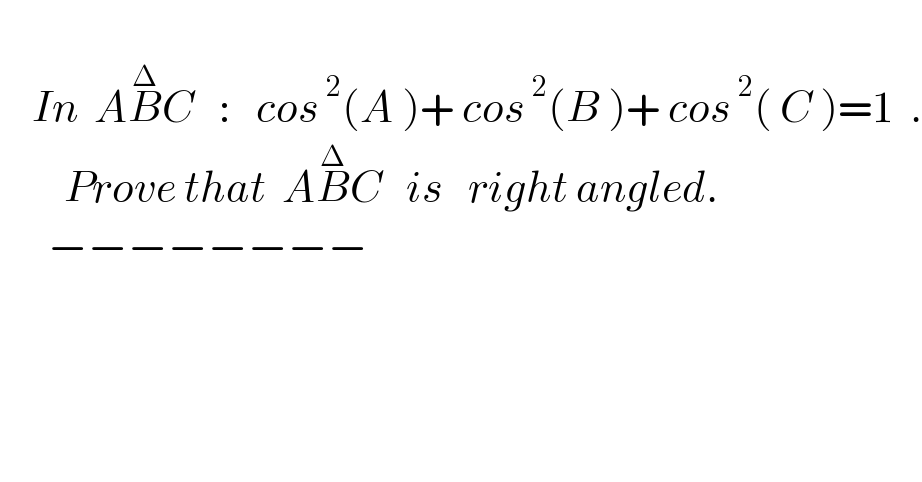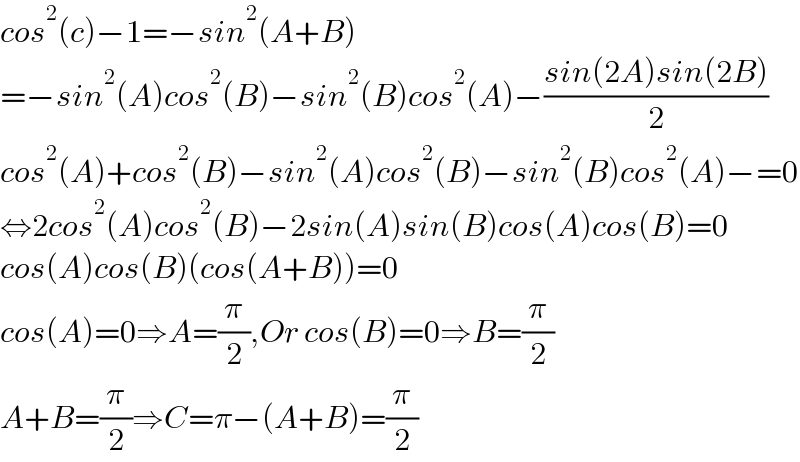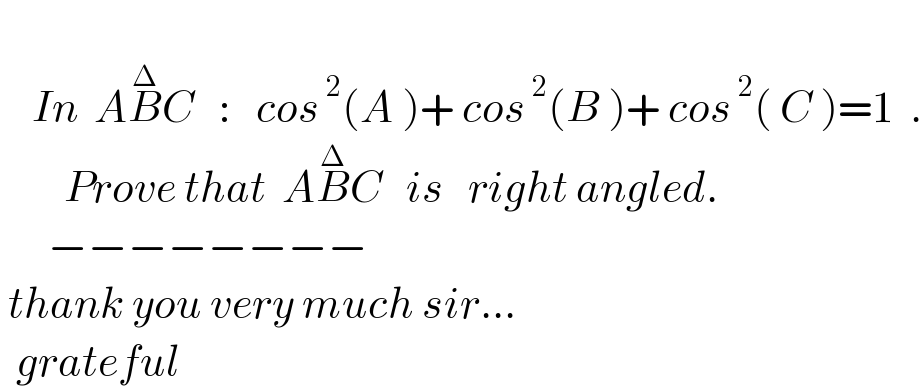Question Number 164339 by mnjuly1970 last updated on 16/Jan/22

$$ \\ $$$$\:\:\:\:{In}\:\:{A}\overset{\Delta} {{B}C}\:\:\::\:\:\:{cos}^{\:\mathrm{2}} \left({A}\:\right)+\:{cos}^{\:\mathrm{2}} \left({B}\:\right)+\:{cos}^{\:\mathrm{2}} \left(\:{C}\:\right)=\mathrm{1}\:\:. \\ $$$$\:\:\:\:\:\:\:\:{Prove}\:{that}\:\:{A}\overset{\Delta} {{B}C}\:\:\:{is}\:\:\:{right}\:{angled}. \\ $$$$\:\:\:\:\:\:−−−−−−−− \\ $$$$\:\:\:\:\:\: \\ $$
Answered by mindispower last updated on 17/Jan/22

$${cos}^{\mathrm{2}} \left({c}\right)−\mathrm{1}=−{sin}^{\mathrm{2}} \left({A}+{B}\right) \\ $$$$=−{sin}^{\mathrm{2}} \left({A}\right){cos}^{\mathrm{2}} \left({B}\right)−{sin}^{\mathrm{2}} \left({B}\right){cos}^{\mathrm{2}} \left({A}\right)−\frac{{sin}\left(\mathrm{2}{A}\right){sin}\left(\mathrm{2}{B}\right)}{\mathrm{2}} \\ $$$${cos}^{\mathrm{2}} \left({A}\right)+{cos}^{\mathrm{2}} \left({B}\right)−{sin}^{\mathrm{2}} \left({A}\right){cos}^{\mathrm{2}} \left({B}\right)−{sin}^{\mathrm{2}} \left({B}\right){cos}^{\mathrm{2}} \left({A}\right)−=\mathrm{0} \\ $$$$\Leftrightarrow\mathrm{2}{cos}^{\mathrm{2}} \left({A}\right){cos}^{\mathrm{2}} \left({B}\right)−\mathrm{2}{sin}\left({A}\right){sin}\left({B}\right){cos}\left({A}\right){cos}\left({B}\right)=\mathrm{0} \\ $$$${cos}\left({A}\right){cos}\left({B}\right)\left({cos}\left({A}+{B}\right)\right)=\mathrm{0} \\ $$$${cos}\left({A}\right)=\mathrm{0}\Rightarrow{A}=\frac{\pi}{\mathrm{2}},{Or}\:{cos}\left({B}\right)=\mathrm{0}\Rightarrow{B}=\frac{\pi}{\mathrm{2}} \\ $$$${A}+{B}=\frac{\pi}{\mathrm{2}}\Rightarrow{C}=\pi−\left({A}+{B}\right)=\frac{\pi}{\mathrm{2}} \\ $$
Commented by mnjuly1970 last updated on 18/Jan/22

$$ \\ $$$$\:\:\:\:{In}\:\:{A}\overset{\Delta} {{B}C}\:\:\::\:\:\:{cos}^{\:\mathrm{2}} \left({A}\:\right)+\:{cos}^{\:\mathrm{2}} \left({B}\:\right)+\:{cos}^{\:\mathrm{2}} \left(\:{C}\:\right)=\mathrm{1}\:\:. \\ $$$$\:\:\:\:\:\:\:\:{Prove}\:{that}\:\:{A}\overset{\Delta} {{B}C}\:\:\:{is}\:\:\:{right}\:{angled}. \\ $$$$\:\:\:\:\:\:−−−−−−−− \\ $$$$\:{thank}\:{you}\:{very}\:{much}\:{sir}… \\ $$$$\:\:{grateful}\:\:\:\:\:\:\:\:\:\: \\ $$
Commented by mindispower last updated on 19/Jan/22

$${wihe}\:{Pleasur}\:{have}\:{a}\:{nice}\:{day} \\ $$
